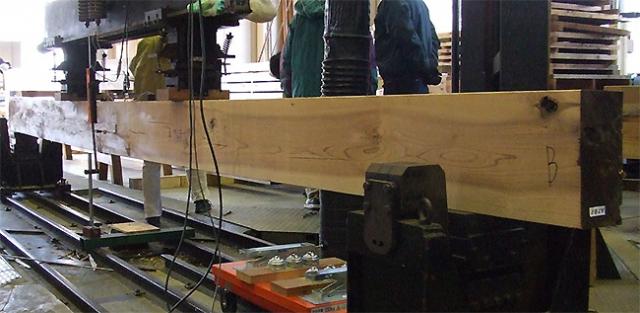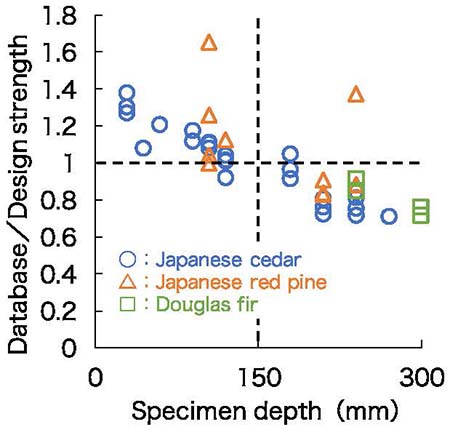Home > Research > Research Results > Research Results 2020 > Safer use of beams with large cross-sections
Update:May 14, 2020
Main content starts here.
Safer use of beams with large cross-sections
| Article title |
Influence of the size effect parameter on the bending strength of lumber (in Japanese with English summary) |
|---|---|
| Author (affiliation) |
Hirofumi IDO (a), Hideo KATO (a) , Hirofumi NAGAO (a) (a) Department of Wood Engineering, FFPRI, Tsukuba, Ibaraki, Japan. |
| Publication Journal |
Bulletin of the Forestry and Forest Products Research Institute, 19(1)(No.453), 79-87, March 2020, FFPRI, |
| Content introduction |
Most of the artificial forests in Japan generally grow past the 50-year harvest period, with trees having large diameters. As a result, the wood from such trees can now be used not only for columns, but also to produce lumber with greater specimen depth (longer side of a member section) such as beams. However, it is known that the larger the specimen depth is, the less strength the lumber has per unit cross-sectional area. This is because as the specimen depth increases, the probability increases that there will be defects in the strength due to an increase in the number of knots, etc. However, little is known about the relationship between specimen depth and strength in Japanese lumber. The FFPRI receives data on strength tests of lumber from public forest research institutes throughout Japan, which are compiled into a strength database. Using this database, we examined the relationship between specimen depth and bending strength from data on about 10,000 pieces of lumber from Japanese cedar, Japanese red pine, and Douglas fir. As a result, we found that as the specimen depth of lumber increased from 150mm to 300mm, the bending strength decreased by about 70-80%. Based on this result, we proposed an index for the reduction of bending strength. The bending strength of the lumber used in the present design (design strength) assumes a specimen depth of about 150mm. However, there is concern that some lumber with a larger specimen depth would not meet the design strength. Therefore, in the present study, safer wood structures can be designed by multiplying our proposed bending strength reduction index by design strength.
Photo: Scene of a bending test of Japanese cedar lumber having a specimen depth of 300mm.
Each of the symbols of the tree species shows a specific value derived from the results of multiple specimens. We can see that when the specimen depth exceeds 150mm, the bending strength obtained from the database is less than the design strength. |
Copyright © Forest Research and Management Organization. All rights reserved.


